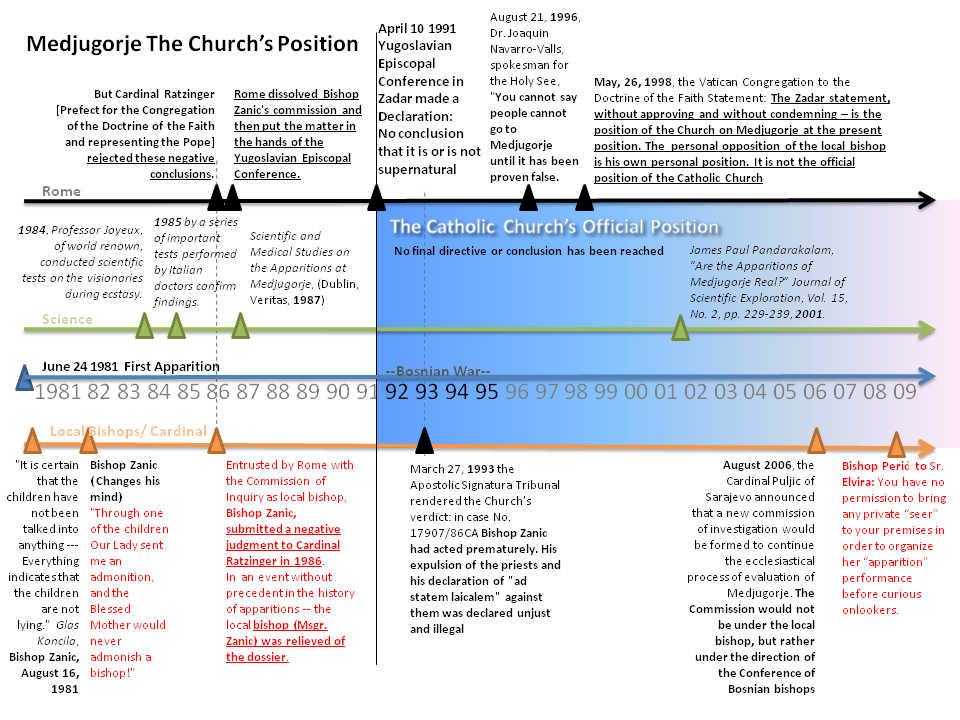This page contains several different views of the answer. There are entire books written on this topic, so to keep it to the point I have included only pertinent facts. Because there are many sides to the topic, from personal opinions to official declarations, and even unprecedented procedures by the Catholic Church (as far as apparitions are concerned, it can get confusing. So I have prepared a time-line chart of major points to hopefully make it clearer to those who ask the question Click here to download a PDF file of the chart.
Or click the picture to see a larger image. I can personally testify that there is a strong sense of the Holy Spirit emanating from this little village. I believe that the Mother of Jesus is strongly present here as well as the Evil One. From Dr. Mark Miravalle Medjugorje Conference Notre Dame University May, 2006.
What is the official position of the Church regarding Medjugorje?
- On April 10, 1991, the Yugoslavian Episcopal Conference made a declaration regarding Medjugorje. It is known as the “Declaration of the ex-Yugoslavian Bishops’ Conference,” in Zadar. In the statement of 1991, the bishops say the following: They do not approve Medjugorje as supernaturally authentic; they do not prohibit Medjugorje as a fraudulent apparition. They rather conclude, without saying a positive statement of Medjugorje, that the pilgrims can come, and they are to be pastorally tended to.
- From the Letter “On the basis of the investigations so far, it can not be affirmed that one is dealing with supernatural apparitions and revelations.”
- “Constat de supernaturalitate.” An approved apparition ,which means it consists of a supernatural origin. For Example Fatrima or Lourdes
- “Constat de non- supernaturalitate.” That is where the local bishop says officially these are not approved, and you cannot come, and there can be no sacraments celebrated at this site.
- “Non constat supernaturalitate.” i.e. Medjugorje The Church, and here the Zadar statement, does not approve the apparitions, it does not discredit the apparitions, and people are, indeed, free to go. It is not yet possible to declare the supernatural reality of the phenomena, but that such a possibility remains open for the future.
Would it be an act of disobedience to pilgrimage to Medjugorje before the Church has given the apparitions final and definitive approval?
- May, 26, 1998, the Vatican Congregation to the Doctrine of the Faith Statement.led by Archbishop Bertone Stated:
- The Zadar statement, without approving and without condemning – is the position of the Church on Medjugorje at the present position.
- The statement of Archbishop Bertone stated that the personal opposition of the local bishop is his own personal position. It is not the official position of the Catholic Church, and I quote from the letter,“ that the position of Msgr. Peric is and remains his personal opinion.”
- Pilgrims can pilgrimage to Medjugorje on a private, personal, that means non-diocesan organized basis.
- This is Rome; this is the Holy See, this is the Vatican Congregation for the Doctrine of the Faith saying that the position of the local bishop, which is a negative position, is not the official Catholic position at this time. Therefore it absolutely is not an act of disobedience
Is there acts of disobedience by the Franciscan priests at St. James parish in Medjugorje against their local bishop?
- The Church at present provides people not only personal belief in Medjugorje but the right to pilgrimage to Medjugorje. That includes the personal rights of the Franciscan priests at Medjugorje.
- They have the freedom on a personal level to exercise the right that the Church gives them to personally say, “Yes, I believe Medjugorje is authentic and I will continue to believe so as the investigation continues.”
- Therefore, any accusations of disobedience by the Franciscan priests at Medjugorje, because they believe in Medjugorje, is intrinsically an invalid accusation.
- There are no reported cases of disobedience by the priests in Medjugorje in violating any canonically licit directive of the bishop.
Can these apparitions really be true when they’ve been reportedly happening for so long?
- The Church has no criteria of length when it investigates reported revelations.
- The Medjugorje apparitions are of no sense the longest apparitions or mystical experiences. And let me give you a few cases
- We have the apparitions and visions of St. Bridget of Sweden in the 14th century, which lasted well over 25 years.
- In the same 14th century, there were the visions and apparitions of St. Gertrude, which lasted over 30 years.
- We have the 12th-century visions and mystical experiences of St. Hildegard which lasted over 65 years!
- It will be known more publicly that Sr. Lucia of Fatima continued to have supernatural communications very close to the year she died, in the first part of the 21st century.
- A newly approved apparition in France, Our Lady of Laus, where the visionary had apparitions for over 50 years!
Do the messages reported by the visionaries contain false teachings regarding ecumenism which contradicts the official teachings of the Catholic Church’s magisterium?
- The message of Medjugorje has been examined thoroughly by a great number of recognized scholars, In fact, well over 20 years ago there was a doctoral dissertation on the subject of the message of Medjugorje, the thesis of which was simply to say, “The message of Medjugorje as reported is in conformity with Scripture, the Fathers of the Church, the Second Vatican Council, and the messages of Lourdes and Fatima, on the basis of private revelation.” And that thesis was accepted as a legitimate thesis at the Pontifical University in Rome.
- Since that time, there has been a great score of theologians and bishops and priests and religious who have examined the message and have not found a single doctrinal error.
- The posed objection is the issue of ecumenism, so let’s be as fair as we can to the objection. There have been two messages reportedly from the Mother of God in Medjugorje on the issue of ecumenism, and I want to read both of them to you.
- In God’s eyes there are no divisions and there are no religions. You in the world have made the divisions. The one Mediator is Jesus Christ. Which religion you belong to cannot be a matter of indifference. The presence of the Holy Spirit is not the same in every church.”
- “The Madonna deplores the lack of religious unity, especially in the villages. She said that everybody’s religion should be respected and of course, one’s own.”
- So what does the message reportedly say?
- Man has made the divisions.
- All religions do not have equal presence of the Holy Spirit,
- The dimension of respecting religions, even if it’s not your particular religion.
- From the Second Vatican Council: ” The Catholic Church rejects nothing of what is true and holy in other religions. She has a high regard for their manner of life and conduct, precepts and doctrine, which although different in many from her own teachings, nevertheless often reflect a ray of that truth which enlightens all men. Yet, she is in duty, bound to proclaim without fail Christ, Who is the Way, the Truth and the Life. In Him, in Whom God reconciled all things to Himself, men find the fullness of their religious life.”
- The documents of the Second Vatican Council, the Catechism of the Catholic Church, and the Pontifical Magisterium tell us that there is only one true Church. It is one, holy, Catholic and apostolic in its fullness. And yet elements of truth can be found in certain degrees in other religions. But ultimately we’re also called to respect the religions of other individuals, even if there’s a disagreement about the truth that’s being posed or the theological position that’s being posed.
- The Medjugorje message as it’s relayed is a complete capsule of the teachings of the Second Vatican Council and the Catholic Catechism. The fullness of Catholic truth, and respect for other religions, and is indeed the Medjugorje message regarding ecumenism.
Medjugorje, What Does the Church Say?
Written by Sr. Emmanuel and Denis Nolan After having given his support to the testimony of the six visionaries at the beginning of the apparitions (“It is certain that the children have not been talked into anything — Everything indicates that the children are not lying.” Glas Koncila, August 16, 1981), Bishop Zanic, the Bishop of Mostar, changed his mind and denied their authenticity. Entrusted by Rome with the Commission of Inquiry as local bishop, he submitted a negative judgment to Cardinal Ratzinger in 1986. This judgment was printed in the newspapers and many Christians, even among the clergy, have not received further information. But Cardinal Ratzinger [Prefect for the Congregation of the Doctrine of the Faith and representing the Pope] rejected these negative conclusions. And — an event without precedent in the history of apparitions — the local bishop (Msgr. Zanic) was relieved of the dossier. This fact was not widely reported. Rome dissolved Bishop Zanic’s commission and then put the matter in the hands of the Yugoslavian Episcopal Conference. A new commission was consequently appointed under the presidency of Bishop Komarica (of Banja Luka, Bosnia-Hercegovina). In 1984 – 85, Professor Joyeux, of world renown, conducted scientific tests on the visionaries during ecstasy. His research, presented with Fr. Rene Laurentin in Scientific and Medical Studies on the Apparitions at Medjugorje, (Dublin, Veritas, 1987) discarded definitively the thesis of deceit on the part of the visionaries, as well as that of their psychological diequilibrium. With the responsibility and authority as President of the Bishops’ conference, Cardinal Kuharic said with regard to the Declaration of Zadar:“After three years of study conducted by the appropriate Commission, we Bishops have accepted Medjugorje as a place of prayer, as a sanctuary — With regard to the supernatural factor of the apparitions, we have said that for now we cannot affirm that it exists — We therefore leave this aspect for further investigation. The Church is in no hurry,”. (Glas Koncila, August, 1993) On August 21, 1996, Dr. Joaquin Navarro-Valls, spokesman for the Holy See, instructed the Catholic News Service; “You cannot say people cannot go [to Medjugorje] until it has been proven false. This has not been said, so anyone can go if they want.” “In addition,” clarified a CNS report issued later that day, “when Catholic faithful go anywhere, they are entitled to spiritual care, so the church does not forbid priests to accompany lay-organized trips to Medjugorje in Bosnia-Hercegovina. Navarro-Valls insisted ‘nothing has changed’ regarding the Vatican’s position on Medjugorje — ‘Has the church or the Vatican said no (to Catholics visiting Medjugorje)? No!'” (CNS News Release, August 21, 1996) On March 22, 1995, Archbishop Frane Franic, Ordinary at the time of the Metropolitan See that in 1981 included Medjugorje, informed Sr. Emmanuel and Denis Nolan that at a meeting of the BYC (Bishops/ Conference of Yugoslavia) held soon after Bishop Zanic had changed his mind, he explained before the Bishops’ Conference why he had done so.“Through one of the children Our Lady sent me an admonition, and the Blessed Mother would never admonish a bishop!” The Conference granted Bishop Zanic’s request, and Archbishop Franic’s response, “But in the Book of the Apocalypse [Revelation] the Holy Spirit admonishes seven Bishops,” was not recorded in the minutes of their meeting. Diocesan and Parish records confirm that in 1981, Vicka Ivankovic, one of the visionaries in Medjugorje, relayed to the Bishop – in regard to his treatment of two Franciscan priests, Fr. Vego and Fr. Prusian – who had appealed their case to Our Lady through the visionaries: “The Gospa wants it said to the bishop that he has made a premature decision. Let him reflect again, and listen well to both parties he must be just and patient. She says that both priests are not guilty, ” (Parish Chronicle, p43). (The bishop had severly disciplined the priests for having administered the sacraments to Catholics who had chosen to attend Mass in their Franciscan chapel in Mostar instead of the church in Mostar he had taken from the Franciscans and given to the secular clergy as part of his Cathedral parish.) “This support given against the authority of the Church,” Bishop Zanic declared at that time, “proves that it is not the Virgin!” On March 27, 1993 – more than 10 years later – the highest Tribunal of the Holy See (the Apostolic Signatura Tribunal) rendered the Church’s verdict: in case No. 17907/86CA Bishop Zanic had acted prematurely. His expulsion of the priests and his declaration of “ad statem laicalem” against them was declared unjust and illegal, (Mir i Dobro, No. 2, 1993)



.jpg)
